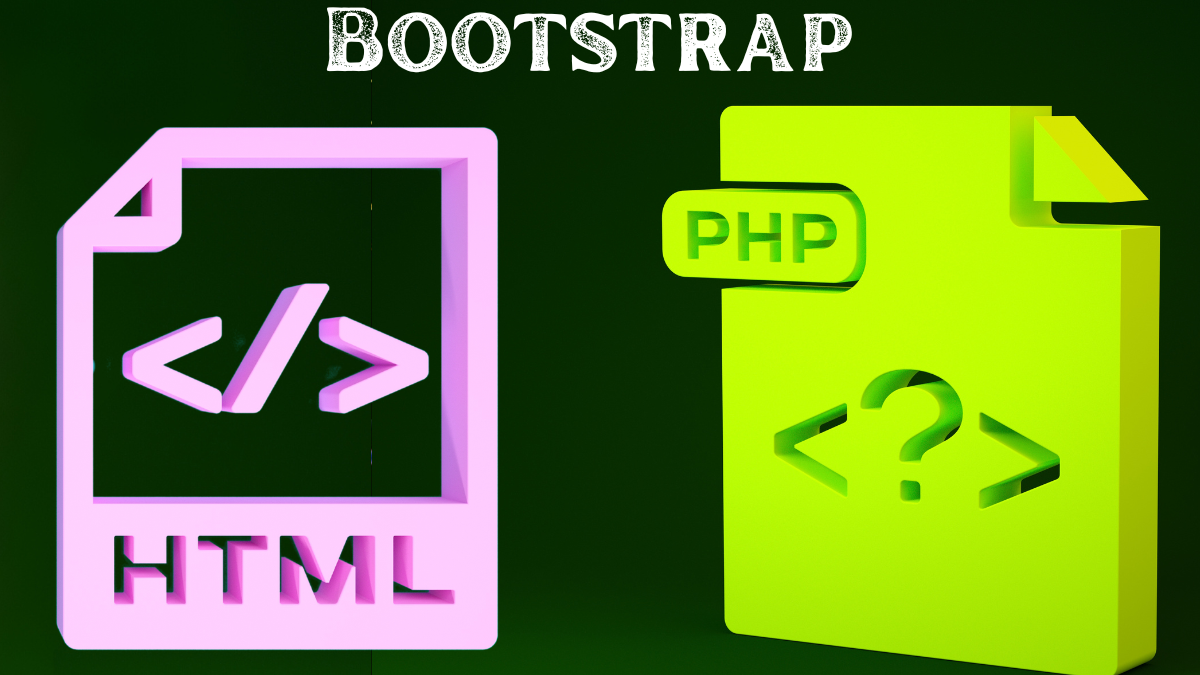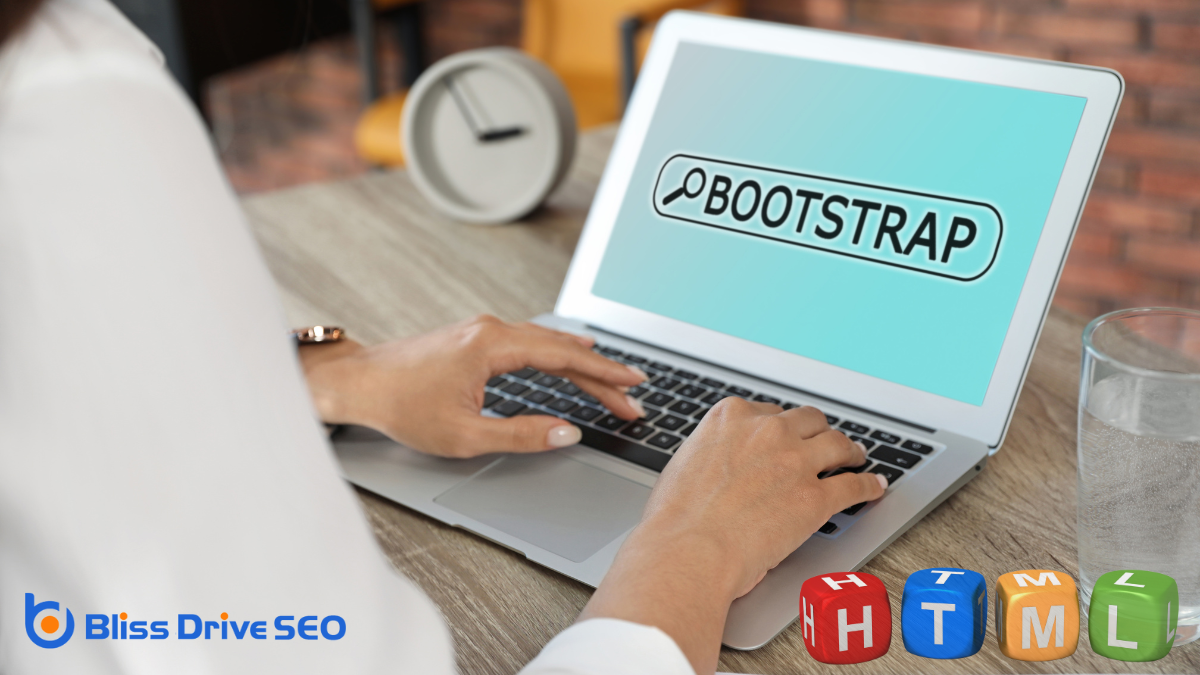', but with Bootstrap, these elements gain extra functionality through specific class names. For instance, using the 'container' class helps you create a responsive layout that adapts to different screen sizes.
Bootstrap's grid system is another example. By using a series of rows and columns, you can create complex layouts without a lot of custom CSS. Just apply classes like 'row' and 'col', and Bootstrap handles the rest.
This structure makes it easier to focus on your content rather than the intricacies of layout design. Understanding Bootstrap's HTML structure allows you to build efficient and responsive websites more effectively.
HTML Components Utilization
In the domain of web development, HTML components play an essential role in harnessing the full potential of Bootstrap.
You'll find that Bootstrap relies heavily on HTML to provide a range of components that enhance your website's functionality and appearance. It's not just about style; it's about creating a seamless user experience.
Here's how you can effectively utilize HTML components in Bootstrap:
- Responsive Layouts: Bootstrap's grid system is built using HTML classes. By adding these classes to your HTML elements, you can create responsive layouts that adjust to different screen sizes effortlessly.
- Navigation Bars: With a few lines of HTML, you can create a fully functional navigation bar. Bootstrap's pre-defined classes help you customize menus that are both mobile-friendly and visually appealing.
- Modals and Alerts: HTML components in Bootstrap allow you to implement interactive elementsElements that require user interaction, such as buttons, forms, and sliders. like modals and alerts. These components improve user engagementThe level of interaction and involvement users have with social media content. by providing feedback and capturing attention.
- Forms and Inputs: Bootstrap enhances standard HTML form elements with additional styling and functionality. Using Bootstrap's classes, you can create forms that aren't only functional but also attractive and user-friendly.
How Bootstrap Uses CSS
When working with Bootstrap, you'll notice it heavily relies on CSS to create a responsive design framework.
It provides predefined CSS classes that help you quickly style elements without writing custom CSS from scratch.
This makes it easier to build flexible, mobile-friendly websites with consistent styling.
Responsive Design Framework
A responsive design framework like Bootstrap revolutionizes how you create dynamic, adaptable websites.
By leveraging CSS, Bootstrap guarantees your site looks great on any device, whether it's a desktop, tablet, or smartphone. You'll find that understanding how Bootstrap utilizes CSS for responsive design can greatly streamline your development process.
Here's how Bootstrap makes your site responsive:
- Grid System: Bootstrap's 12-column grid system allows you to easily align content and reorder columns across different screen sizes. This flexibility guarantees your layout adapts perfectly to any screen width.
- Media Queries: Bootstrap uses CSS media queries to apply different styles based on device characteristics like width, height, and orientation. This means your site automatically adjusts its layout without any extra coding on your part.
- Fluid Containers: These containers resize dynamically with the viewport, guaranteeing your content remains proportionate regardless of the user's device.
- Breakpoints: Predefined breakpoints in Bootstrap let you customize how your design changes at specific screen sizes, giving you control over the look and feel of your site at every stage.
Predefined CSS Classes
Some might wonder how Bootstrap simplifies styling with its predefined CSS classes. Bootstrap is like a toolkit filled with ready-to-use CSS classes that help you style your web pages effortlessly. You don't have to start from scratch, because Bootstrap offers a wide range of classes for layout, typography, colors, and more.
When you use Bootstrap, you can easily apply styles by adding specific class names to your HTML elements. For instance, if you want a button to look appealing, just add the class 'btn btn-primary' to your button element, and voila! It automatically adopts a stylish appearance without extra effort. This not only saves you time but also guarantees consistency across your site.
Bootstrap also includes classes for responsive design, meaning your site looks great on any device. By using grid classes like 'col-md-6', you control layout on larger screens and adjust with classes like 'col-sm-12' for smaller ones. It's all about flexibility and efficiency.
With Bootstrap's predefined CSS classes, you're not reinventing the wheel. Instead, you're leveraging a powerful system that enhances your web development process, making it quicker and more straightforward.
JavaScript Components in Bootstrap
Immerse yourself in the dynamic world of JavaScript components in Bootstrap, where interactivity and responsiveness take center stage.
Bootstrap's JavaScript components allow you to enhance your web projects with features that go beyond static pages. They're essential for creating modern, user-friendly interfaces that respond to user actions seamlessly.
Bootstrap's JavaScript components rely on jQuery, providing you with a range of interactive elements. Here are a few key components to explore:
- Modals: Use modals to display content in an overlay, capturing user attention without deviating away from the current page. They're perfect for forms, alerts, or important messages.
- Dropdowns: Easily create dropdown menus that can hold various action items or links. Dropdowns help organize options and actions, keeping your interface tidy and accessible.
- Carousel: Implement carousels to display a series of content or images in a slideshow format. They allow for smooth shifts and can be customized to autoplay or respond to user movement.
- Collapse: This component enables you to hide or show content sections dynamically, optimizing space and enhancing user experience by revealing information only when needed.
Comparing Bootstrap and PHP
Bootstrap and PHP, though both pivotal in web development, serve distinct roles and purposes.
Bootstrap is a front-end framework that focuses on making the design and layout of web pages responsive and visually appealing. It uses HTML, CSS, and JavaScript to provide components like navigation bars, forms, and modals, all designed to streamline your user interface development process. You can think of Bootstrap as your toolkit for crafting the look and feel of your site's client-side experience.
On the other hand, PHP is a server-side scripting language. It handles the behind-the-scenes operations of a website, like interacting with databases, processing form submissions, and managing sessions. PHP runs on the server and generates the HTML content that gets sent to the user's browser, making it a powerful tool for dynamic web applications.
While Bootstrap enhances user experience by providing pre-designed components and guaranteeing your site looks great on any device, PHP guarantees your site operates smoothly and efficiently by managing data and server interactions.
Understanding the difference between Bootstrap and PHP helps you decide when to use each, ultimately creating a more robust and user-friendly website.
Integrating Bootstrap With PHP
When you integrate Bootstrap with PHP, you're combining the power of dynamic server-side scripting with the elegance of responsive front-end design.
This powerful duo can elevate your web development projects by providing a seamless user experience with efficient functionality. While PHP handles the server-side operations like database interactions and content management, Bootstrap guarantees your site looks great on any device.
To get started with integrating Bootstrap and PHP, follow these steps:
- Set Up Your Project: Confirm you have Bootstrap files linked in your project. You can either download them or use a CDN for quick integration.
- Create a PHP Template: Use PHP to generate HTML content. This can include headers, footers, and navigation bars, making it easier to manage and update your content.
- Incorporate Bootstrap Classes: Apply Bootstrap's CSS classes to your PHP-generated HTML elements. This will give your site a consistent, responsive design with minimal effort.
- Dynamic Content Loading: Use PHP to pull data from a database and display it using Bootstrap's components. This approach keeps your website dynamic and visually appealing.
Benefits of Using Bootstrap
With the ever-evolving landscape of web development, incorporating a framework like Bootstrap offers numerous advantages.
First, you'll appreciate how it simplifies the design process. Bootstrap comes with pre-designed components like buttons, forms, and navigation bars, saving you time and ensuring consistency across your site. You won't have to start from scratch, which means you can focus more on the functionality and customization of your project.
Another benefit is responsiveness. Bootstrap is built to be mobile-first, meaning your site will automatically adjust to different screen sizes. This adaptability is essential in today's mobile-driven world, ensuring your site looks great on any device without extra effort on your part.
Additionally, Bootstrap has a vast community and extensive documentation. If you run into issues or need inspiration, you'll find countless resources and forums where fellow developers share solutions and ideas. This support can be invaluable, especially when you're tackling complex projects.
Finally, Bootstrap's integration capabilities can't be overlooked. Whether you're working with HTML, CSS, or PHP, Bootstrap is designed to work seamlessly, allowing you to build dynamic and visually appealing websites with ease.
Conclusion
In integrating Bootstrap with PHP, you're enhancing your web development process by combining Bootstrap's sleek, responsive design capabilities with PHP's dynamic functionality. Bootstrap is all about HTML and CSS, but its real power shines when PHP handles server-side tasks, generating dynamic content effortlessly. By merging these tools, you're creating websites that are not only visually appealing but also highly functional and adaptive. Embrace this synergy to deliver a seamless user experience across all devices.


